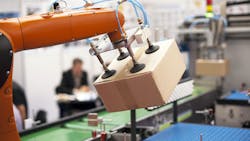Will a robot run my organization in 10 years?
Maybe. I know a chief executive’s job, which requires a fair amount of problem-solving and creativity, is probably less susceptible to automation than middle-skill jobs such as machining and bookkeeping. At the same time, new research shows that most jobs have some proportion of tasks that can be substituted by workplace automation. Including a CEO’s job.
Concerns about technology replacing workers isn’t new. Over the past 200 years, mechanical looms replaced artisans, electric streetlights displaced lamplighters, cars replaced horses (thus limiting the need for blacksmiths) and personal computers diminished the need for typists. Technological advances have long taken a toll on specific professions and industries. They also raise our overall living standards.
The difference today is that digitization is dramatically reducing transaction costs and helping spread the changes farther and faster than before. Moreover, a new kind of automation—artificial intelligence—puts different kinds of jobs at risk than the mechanical automation of previous eras. Particularly affected are tasks that require cognitive skills, many of which are found in middle-skill jobs.
So we now see increased anxiety related to the impact of technology and automation on the future workforce, which is leading to a steady stream of academic and commercial research. MIT's Andrew McAfee and Erik Brynjolfsson published The Second Machine Age in 2014, a relatively upbeat assessment of the impact of new technology on the workforce. In 2015, Martin Ford’s Rise of the Robots drew attention with its dire outlook and dramatic policy proposals, even winning the FT & McKinsey Business Book of the Year Award. Among Ford’s policy prescriptions: a guaranteed basic income for families (an idea introduced a half-century ago by President Johnson’s National Commission on Technology, Automation, and Economic Progress).
New Technology
In November, McKinsey Global Institute published a report suggesting that based on current technologies, most jobs (95%) won’t be jeopardized over the next five years. But new technology will change them. Authors Michael Chui, James Manyika, and Mehdi Miremadi looked at 2,000 distinct types of work activities in 800 occupations and found that 45% of work activities could be automated, affecting workers in a wide variety of roles. For example, up to 20% of the activities of a chief executive could be automated, such as analyzing operations data and reviewing status reports.
As MIT economics professor David Autor observes, this is part of the evolution and improvement of working conditions. In a 2014 study, he described how, because of Polanyi’s paradox—the concept that humans know more than we can describe—we’ll never be able to program a computer to mimic certain abilities. While robots can apply math to carry out routine tasks, humans must complement their robot “colleagues” with nonprogrammable capabilities, such as the ability to be flexible and use common sense to solve unexpected problems.
In 2015, Autor published a paper in the Journal of Economic Perspectives that explained why automation advances up to this point have not eliminated most jobs. His main premise: while workplace technologies may substitute for labor, those that cannot be substituted are generally complemented by it. For example, as the number of ATMs in the country quadrupled between 1980 and 2010, the number of bank employees increased. ATMs reduced the number of cash-handling tasks but technology provided new data on customers and thus new opportunities for banks to become more involved in relationship banking. Tellers became sales representatives.
Productivity Gains
Autor points out we’ve seen automation in agriculture and manufacturing replace “physically demanding, dangerous, and menial work,” creating safer, less onerous working conditions for many in the middle class. Moreover, many productivity gains from workforce automation have increased the demand for goods and services, in turn increasing the demand for new forms of labor.
Change is upon us. As McKinsey’s authors advise, in this era of rapid technological changes, the smart approach is to keep track of the speed and direction of automation, understand the needs and requirements to stay competitive, and determine where, when and how much to invest in automation.
Even if it’s at the expense of a chief executive’s job.
About the Author

Stephen Gold
President and Chief Executive Officer, Manufacturers Alliance
Stephen Gold is president and CEO of Manufacturers Alliance. Previously, Gold served as senior vice president of operations for the National Electrical Manufacturers Association (NEMA) where he provided management oversight of the trade association’s 50 business units, member recruitment and retention, international operations, business development, and meeting planning. In addition, he was the staff lead for the Board-level Section Affairs Committee and Strategic Initiatives Committee.
Gold has an extensive background in business-related organizations and has represented U.S. manufacturers for much of his career. Prior to his work at NEMA, Gold spent five years at the National Association of Manufacturers (NAM), serving as vice president of allied associations and executive director of the Council of Manufacturing Associations. During his tenure he helped launch NAM’s Campaign for the Future of U.S. Manufacturing and served as executive director of the Coalition for the Future of U.S. Manufacturing.
Before joining NAM, Gold practiced law in Washington, D.C., at the former firm of Collier Shannon Scott, where he specialized in regulatory law, working in the consumer product safety practice group and on energy and environmental issues in the government relations practice group.
Gold has also served as associate director/communications director at the Tax Foundation in Washington and as director of public policy at Citizens for a Sound Economy, a free-market advocacy group. He began his career in Washington as a lobbyist for the Grocery Manufacturers of America and in the 1980s served in the communications department of Chief Justice Warren Burger’s Commission on the Bicentennial of the U.S. Constitution.
Gold holds a Juris Doctor (cum laude) from George Mason University School of Law, a master of arts degree in history from George Washington University, and a bachelor of science degree (magna cum laude) in history from Arizona State University. He is a Certified Association Executive (CAE).
